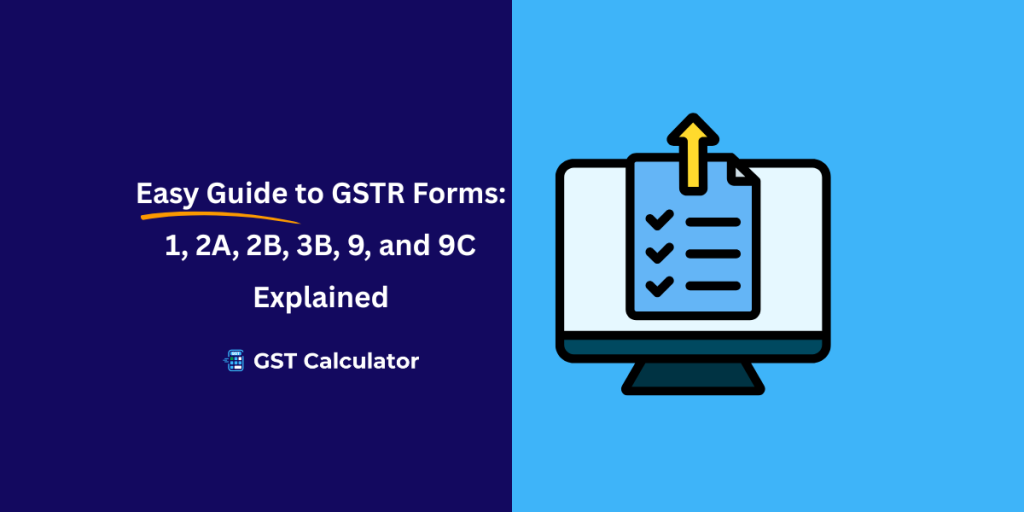Navigating the world of Goods and Services Tax (GST) in India involves understanding various forms, each with its own purpose. These GSTR forms are how businesses report their transactions and tax liabilities to the government.
It can seem a bit confusing at first, with so many different numbers and letters, but once you break them down, it makes more sense.
This guide will walk you through the main GSTR forms you’ll likely encounter, explaining what they are and why they matter for your business.
Key Takeaways
- GSTR-1 is where you report all your sales and outward supplies for a given period.
- GSTR-3B is a simplified monthly summary of your tax liability, based on your reported sales and claimed input tax credit.
- GSTR-2A shows you a view of the purchases reported by your suppliers, helping you track potential input tax credit (ITC).
- GSTR-2B is a static, monthly statement that details your available ITC based on your suppliers’ filings, making it easier to claim.
- GSTR-9 and GSTR-9C are annual returns used for a yearly summary and reconciliation of your GST data, respectively.
Understanding Core GSTR Forms
Alright, let’s get down to the nitty-gritty of the GST returns that most businesses deal with on a regular basis. These are the forms you’ll be interacting with most frequently, so getting a handle on them is pretty important. Think of them as the building blocks for your GST compliance.
The information you put in GSTR-1 is what your customers will see in their GSTR-2A and GSTR-2B, so accuracy is key. It includes details like invoice numbers, dates, values, and the tax charged. If you’ve issued any credit or debit notes, those get reported here too. It’s the primary way the government tracks your outward taxable supplies. You can find more details about GSTR-1 filing.
This is where you report all the sales you’ve made. Basically, every invoice you’ve sent out for goods or services needs to be detailed here. It’s a monthly or quarterly filing, depending on your business size and scheme.
Think of GSTR-3B as your monthly summary report. It’s a self-declared statement where you consolidate your tax liability. You’ll report your total outward supplies, claim your Input Tax Credit (ITC), and then declare the net tax you owe.
This is the form you actually pay your taxes through. It’s important to reconcile the figures in GSTR-3B with what you reported in GSTR-1 and what’s available in GSTR-2B before you file.
This helps avoid discrepancies and potential issues with claiming ITC.
GSTR-2A is a dynamic, system-generated report. It shows all the inward supplies (purchases) that have been reported by your suppliers in their GSTR-1 filings. It’s a view-only document, meaning you can’t make changes directly in it.
Its main purpose is to help you see what purchases your suppliers have declared, which is a big part of how you verify your eligibility to claim Input Tax Credit (ITC). It was the go-to for ITC claims for a while.
Now, GSTR-2B is a bit different from GSTR-2A. It’s a static report that is generated monthly. Unlike GSTR-2A, which updates as suppliers file, GSTR-2B is generated based on the data filed up to a specific cut-off date for the previous month.
This means it provides a fixed snapshot of your available ITC for that particular month. It’s the official document you should rely on for claiming your Input Tax Credit now, as it offers a more definitive view of what you’re eligible to claim.
Annual GSTR Forms for Comprehensive Reporting

Once the monthly hustle of GST filings is done, it’s time to look at the bigger picture. The Goods and Services Tax (GST) system has two main forms for annual reporting that wrap everything up. These are GSTR-9 and GSTR-9C. They’re designed to give a full rundown of your business’s financial activities throughout the year.
GSTR-9: The Annual Return Explained
Think of GSTR-9 as the yearly summary of all your GST returns. It consolidates all the information you’ve reported in your monthly or quarterly returns (like GSTR-1 and GSTR-3B) over the entire financial year. It’s a pretty detailed form, asking for a breakdown of your outward and inward supplies, input tax credit (ITC) claimed, tax paid, and any demands or refunds.
The main goal here is to reconcile the data you’ve already submitted throughout the year.
Here’s a quick look at what it covers:
- Details of outward supplies, broken down by type (taxable, exempt, nil-rated, etc.).
- Reporting of inward supplies and ITC claimed.
- Reconciliation of declared supplies and ITC with figures from GSTR-1 and GSTR-3B.
- Information on taxes paid during the year.
It’s important to get this right because it’s the final annual statement of your GST compliance. For most regular taxpayers, filing GSTR-9 is mandatory if their aggregate turnover exceeds ₹2 crore in a financial year. However, there are some exceptions, like taxpayers opting for the composition scheme, who file a different annual return (GSTR-4).
GSTR-9C: Audited Financial Reconciliation
Now, GSTR-9C is where things get a bit more formal. This form is essentially a reconciliation statement. It compares the details reported in your annual return (GSTR-9) with your audited financial statements. This means you’ll need to have your books of accounts audited by a Chartered Accountant or Cost Accountant.
Here’s what GSTR-9C is all about:
- It verifies that the figures in your GSTR-9 match your audited Profit & Loss account and Balance Sheet.
- It requires a certification from a practicing Chartered Accountant or Cost Accountant.
- It helps identify any discrepancies between your tax filings and your actual financial records.
Who needs to file GSTR-9C? Generally, businesses whose aggregate annual turnover exceeds ₹5 crore are required to file GSTR-9C.
This form adds an extra layer of assurance, making sure that what’s reported for tax purposes aligns with the company’s official financial health. It’s a way to ensure accuracy and prevent tax evasion by cross-referencing official financial records with GST declarations.
Specialized GSTR Forms for Specific Taxpayers
Alright, so not everyone fits into the standard filing boxes. The GST system has a few specific forms designed for particular types of businesses or situations. It’s like having different tools for different jobs, you know?
GSTR-4: For Composition Scheme Taxpayers
If your business is small and you’ve opted for the composition scheme, this is your go-to form. Basically, the composition scheme lets eligible small businesses pay a fixed tax rate on their turnover instead of the regular GST rates. It simplifies things a lot, cutting down on the paperwork and the hassle of filing detailed returns. You’ll file this one annually.
- Who can use it? Businesses with an annual turnover up to ₹1.5 crore (₹75 lakh for special category states).
- What it covers: A summary of your turnover and tax paid under the composition scheme.
- Frequency: Annually.
This scheme is a real lifesaver for small businesses trying to keep things simple and predictable with their tax obligations. It means less time worrying about complex calculations and more time focusing on growing the business.
GSTR-5: Non-Resident Foreign Taxpayer Return
This one’s for those who aren’t residents of India but are still doing business here and need to be registered under GST. Think foreign companies or individuals making taxable supplies in India. It’s a bit more involved because it covers all the ins and outs of your business activities here.
- Who files it? Non-resident foreign taxpayers making taxable supplies in India.
- Details included: Outward and inward supplies, credit/debit notes, taxes paid, and liabilities.
- Frequency: Monthly.
GSTR-5A: OIDAR Service Provider Summary
Got something to do with Online Information and Database Access or Retrieval (OIDAR) services? If you’re providing these kinds of services to customers in India from outside the country, this is your form. It’s a summary return specifically for these types of transactions.
- Purpose: Reports outward taxable supplies and tax payable for OIDAR services.
- Who files it? Foreign-based OIDAR service providers.
- Frequency: Monthly.
GSTR-6: Input Service Distributor Return
An Input Service Distributor (ISD) is a bit unique. They receive invoices for services used by their other branches or locations. GSTR-6 is for these entities to report the distribution of Input Tax Credit (ITC) they’ve received to their various branches.
- Key function: Distributing ITC received on services used across multiple locations.
- Who files it? Input Service Distributors.
- Frequency: Monthly.
So yeah, these forms are there for specific folks who don’t quite fit the regular taxpayer mold. It’s all about making sure everyone’s accounted for, even if their situation is a little different.
Key Aspects of GSTR Forms Filing
Filing your Goods and Services Tax (GST) returns can feel like a puzzle sometimes, with all the different forms and deadlines.
But getting the key aspects right makes the whole process much smoother. It’s not just about ticking boxes; it’s about making sure your tax filings are accurate and you’re claiming all the input tax credit (ITC) you’re entitled to.
Reconciling GSTR-1 and GSTR-2B Before GSTR-3B Filing
This is a big one. Before you even think about filing your monthly GSTR-3B, you absolutely need to cross-check your GSTR-1 details with what’s showing up in your GSTR-2B. GSTR-1 is where you report all your outward sales, and GSTR-2B is a static statement that shows the input tax credit you’re eligible to claim based on what your suppliers have reported in their GSTR-1s.
If these don’t match up, you could be missing out on ITC or, worse, reporting incorrect figures.
Here’s a quick rundown of why this reconciliation is so important:
- Accurate ITC Claims: GSTR-2B provides the definitive list of ITC available to you. Matching it with your own records prevents claiming ITC on purchases that haven’t been properly reported by your vendors.
- Avoiding Mismatches: Discrepancies between GSTR-1 and GSTR-2B can flag your business for scrutiny by tax authorities. Getting it right from the start avoids future headaches.
- Timely Filing: Doing this reconciliation before the GSTR-3B deadline means you can identify and resolve any issues with enough time to spare, preventing last-minute rushes.
Think of it like checking your shopping list against the items in your cart before you head to the checkout. You want to make sure everything is accounted for.
Auto-populated Data in GSTR-9 from GSTR-1 and GSTR-3B
When it comes time to file your annual return, GSTR-9, the GST system does a lot of the heavy lifting for you. Many tables within GSTR-9 are auto-populated with data from your previously filed GSTR-1 and GSTR-3B returns for that financial year. This includes details like:
- Advances received and supplies made
- Outward supplies on which tax isn’t payable
- Total ITC availed through GSTR-3B
- ITC received from Input Service Distributors (ISD)
While this auto-population is a huge time-saver, it’s not foolproof. You still need to review this data carefully. Some fields, like the total ITC availed via GSTR-3B (Table 6A) and ITC as per GSTR-2A (Table 8A), cannot be edited.
This highlights the importance of ensuring your monthly GSTR-1 and GSTR-3B filings are accurate in the first place. You can find more details on how to file your annual return on the GST portal.
Downloading Summaries for GSTR Forms
Need to keep records or prepare for audits? The GST portal allows you to download various summaries and filed returns. This is super handy for keeping your own books updated and for any internal or external audits.
You can download filed returns like GSTR-1, GSTR-3B, and also reconciliation statements like GSTR-2A. Having these downloadable summaries makes it easier to track your tax liabilities and credits over time.
Keeping organized records of all your filed GST returns is not just good practice; it’s a requirement. These documents serve as proof of your tax compliance and are invaluable for financial planning and audits. Make it a habit to download and save copies of every return you file.
Navigating GSTR Forms and Their Purpose

Alright, let’s talk about why these GSTR forms exist and how they fit together. It can seem like a lot at first, but once you get the hang of it, it makes sense. Think of it like a puzzle where each piece has its job.
Purpose of GSTR-1 and GSTR-3B Differences
GSTR-1 is all about reporting what you’ve sold or provided as a service. It’s your outward supply statement, detailing every invoice and credit/debit note. This is what your customers will see reflected in their GSTR-2A, which is pretty important for them to claim their input tax credit (ITC).
On the other hand, GSTR-3B is more of a summary. It’s a monthly self-declaration where you report your total outward supplies, claim your eligible ITC, and declare your tax liability.
The key difference is that GSTR-1 is invoice-specific, while GSTR-3B is a consolidated summary. You can’t just file GSTR-3B without looking at your GSTR-1 and GSTR-2B first. It’s like checking your homework before handing it in.
Importance of GSTR-2A for ITC Claims
So, GSTR-2A is a dynamic, read-only statement. It pulls data directly from the GSTR-1 filings of your suppliers. When your supplier reports a sale to you in their GSTR-1, that information pops up in your GSTR-2A.
This is super important because it’s the primary document that helps you verify and claim your Input Tax Credit (ITC). If a purchase isn’t showing up in your GSTR-2A, you generally can’t claim the ITC for it, unless there are specific exceptions or amendments.
It’s basically a way for the system to match what you say you bought with what your suppliers say they sold to you. This helps prevent fraud and ensures that taxes are accounted for correctly.
Static vs. Dynamic Nature of GSTR-2B
Now, GSTR-2B is a bit different from GSTR-2A. While GSTR-2A is dynamic and updates in real-time as suppliers file their GSTR-1, GSTR-2B is a static statement. It’s generated on a specific date each month and remains unchanged for that period.
This static nature makes GSTR-2B the definitive document for claiming ITC for that particular month. You can download the GSTR-2B summary for your records.
Here’s a quick rundown:
- GSTR-2A: Dynamic, view-only, shows all transactions as they are reported by suppliers.
- GSTR-2B: Static, generated monthly, provides a definitive list of ITC available for the period.
The GST portal uses the data from your filed GSTR-1 and GSTR-3B to auto-populate parts of your annual return, GSTR-9. This means keeping your monthly filings accurate is a big deal for simplifying your year-end reporting. It’s always a good idea to review these auto-populated figures carefully before finalizing your annual return.
Understanding these relationships is key to smooth GST compliance. It’s not just about filling out forms; it’s about how they interact to reflect your business’s financial activity accurately.
Wrapping It Up: Your GSTR Journey
So, we’ve gone through the main GSTR forms – GSTR-1, 2A, 2B, 3B, and the big annual ones, 9 and 9C. It might seem like a lot at first, but honestly, once you get the hang of it, it’s just part of doing business. Think of GSTR-1 as your sales report, GSTR-3B as your monthly summary, and GSTR-9/9C as the year-end wrap-up. GSTR-2A and 2B are basically your purchase statements from others, helping you claim what you’re owed. Keeping these forms straight means fewer headaches later, especially when it’s time for that annual filing. Don’t stress too much; just take it one form at a time. If you get stuck, there are always resources and professionals who can help out.
Frequently Asked Questions
What is the main purpose of GSTR-1 and GSTR-3B?
GSTR-1 is like a report card for your sales. You list all the goods and services you’ve sold during a month or quarter. GSTR-3B is a summary report where you declare how much tax you owe based on your sales and purchases, and how much you’ve already paid. Think of GSTR-1 as telling what you sold, and GSTR-3B as telling how much tax you need to pay for it.
Why is GSTR-2A important for claiming tax credits?
GSTR-2A is like a statement that shows all the purchases you’ve made that your suppliers have reported. It’s important because it helps you check if the tax you paid on your purchases (called Input Tax Credit or ITC) matches what your suppliers have reported. This helps you claim the correct amount of ITC and avoid problems.
What’s the difference between GSTR-2A and GSTR-2B?
GSTR-2A is a dynamic list that updates as soon as your suppliers report their sales. It’s always changing. GSTR-2B, on the other hand, is a snapshot taken on a specific date (usually the 14th of the month). It shows you exactly what tax credits you can claim for that month, and it doesn’t change after it’s generated. It’s like GSTR-2A is a live feed, and GSTR-2B is a printout from that feed.
Do I have to file GSTR-1 if I have no sales?
Even if you haven’t made any sales, you generally still need to file GSTR-1, but you would report ‘Nil’ or zero sales. However, there are some exceptions, like if you’re on the composition scheme or are an input service distributor. It’s always best to check the specific rules for your business.
When do I need to file GSTR-3B?
GSTR-3B is a monthly report. Most businesses need to file it every month. It’s a summary of your sales, purchases, and the tax you need to pay. It’s important to file it on time to avoid penalties.
What is GSTR-9 for?
GSTR-9 is an annual report. It’s like a yearly summary of all the GST returns you filed throughout the year. You use it to report your total sales, purchases, taxes paid, and other details for the entire financial year. It helps ensure everything matches up.

